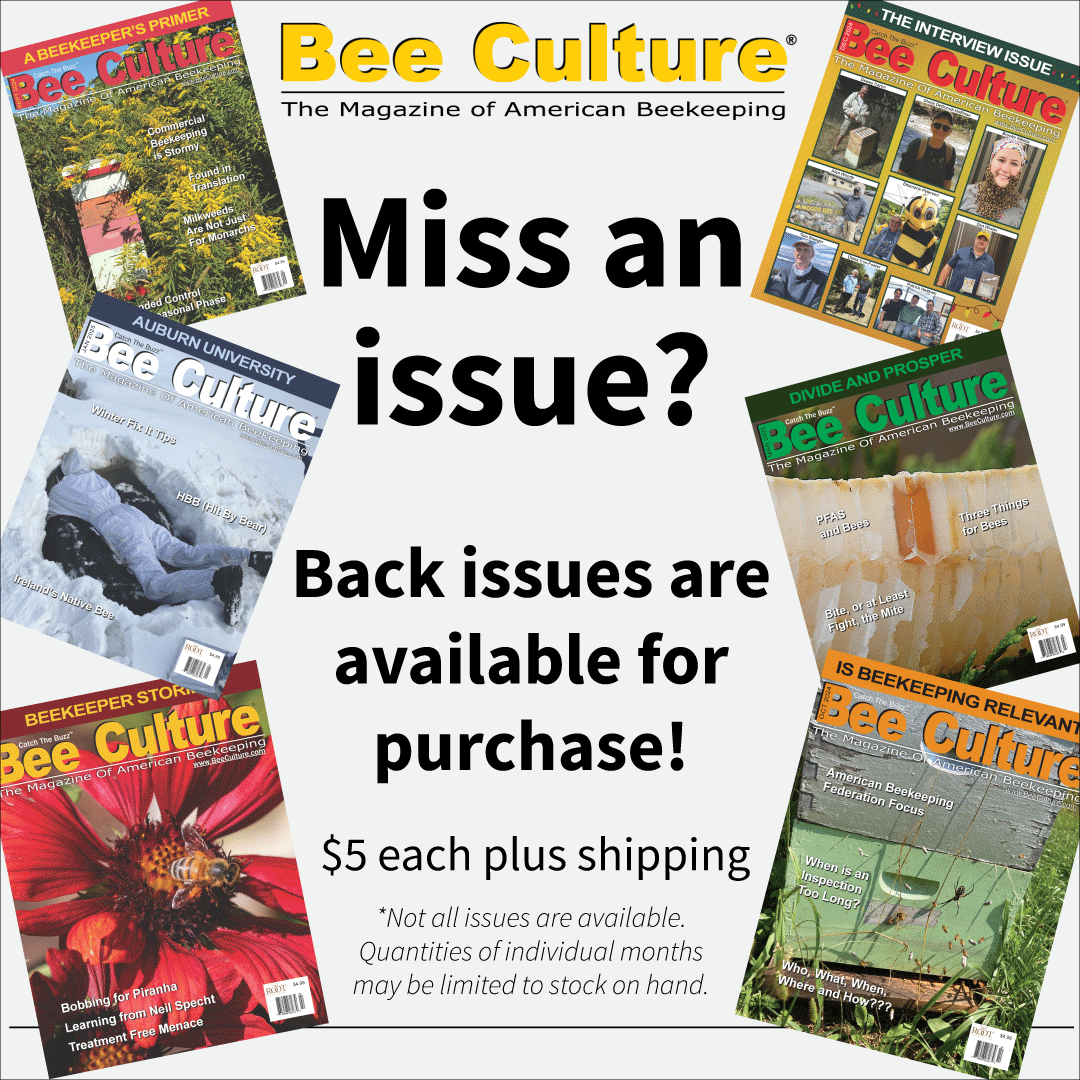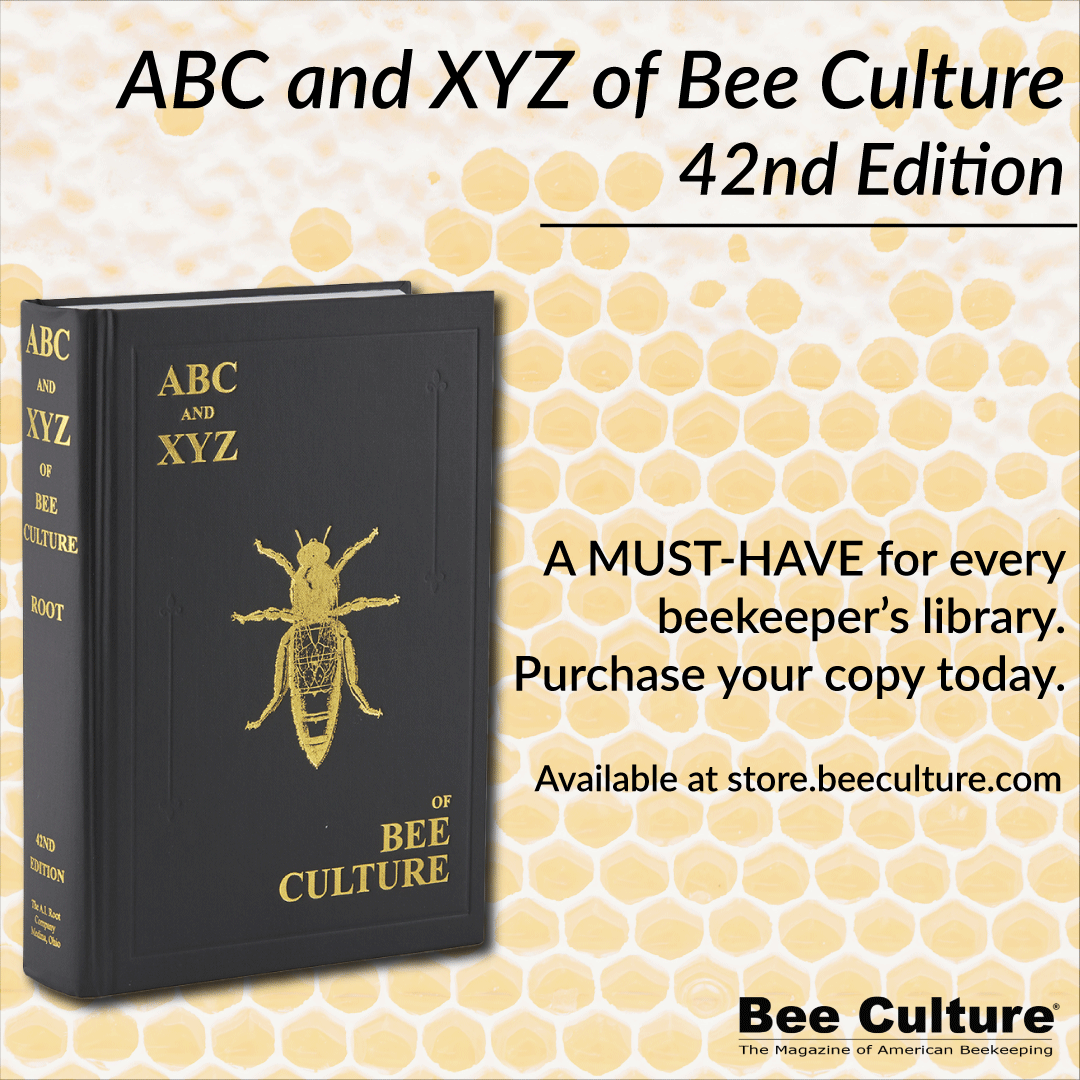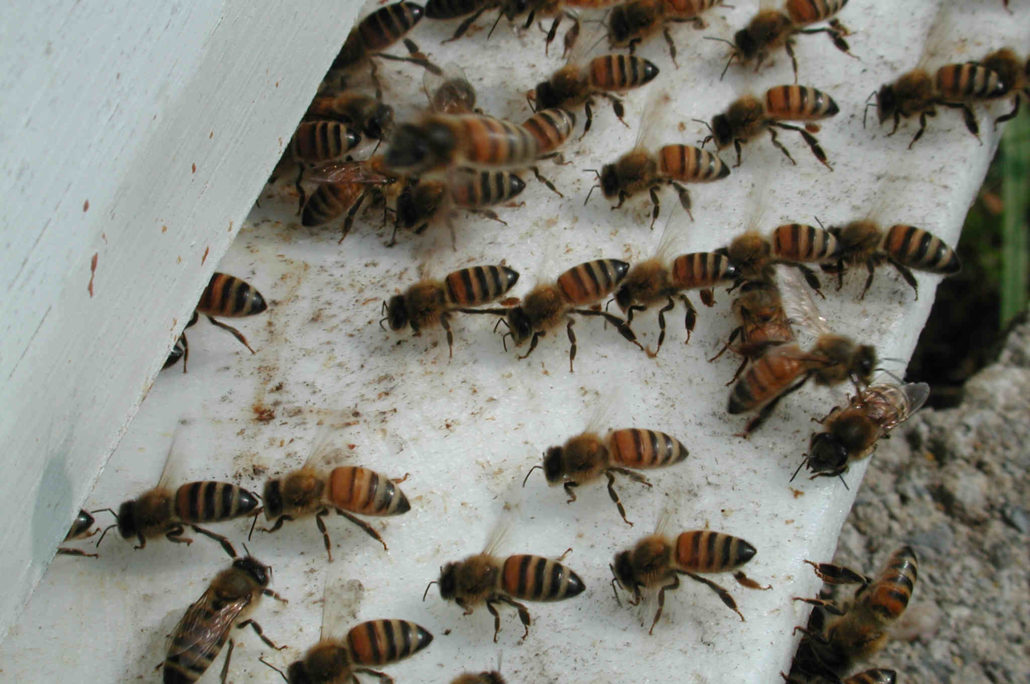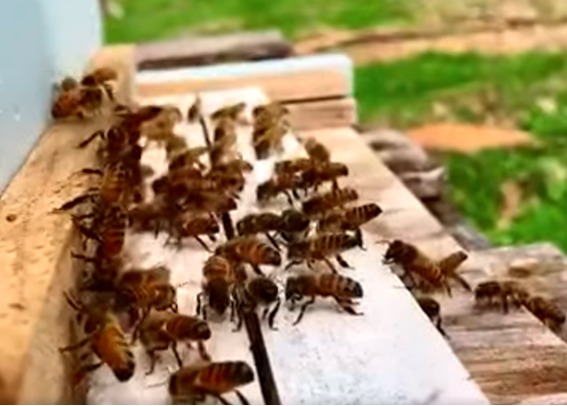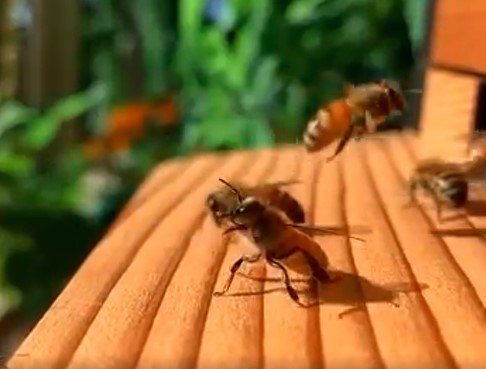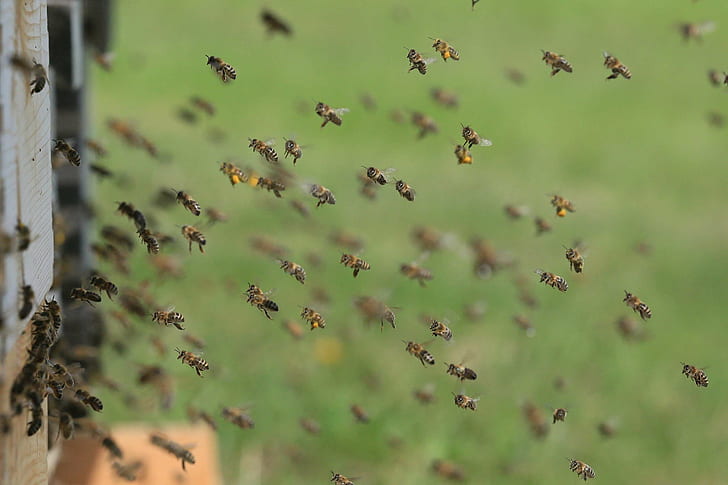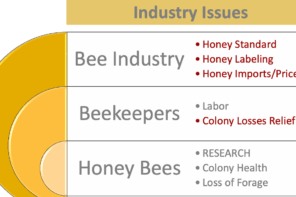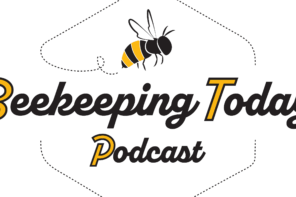Click Here if you listened. We’d love to know what you think. There is even a spot for feedback!
Read along below!
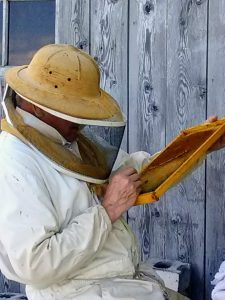
Richard Wahl began learning beekeeping the hard way starting in 2010 with no mentor or club association and a swarm catch. He is now a self-sustainable hobby beekeeper since 2018, writing articles, giving lectures and teaching beginning honey bee husbandry and hive management.
Off the Wahl Beekeeping
New(ish) Beekeeper Column
Observations at the Hive Entrance
By: Richard Wahl
The Asset of a Close Location
Observing bees at the entrance of a hive can reveal a lot about the colony’s well-being and activity. My hive apiary is located on the south side of a hip roof barn beyond several other farm buildings. It is not more than 70 yards away from the side exit door of the garage connected to my house to the north. This makes it easy to walk out to the hives and watch the bee’s comings and goings at any time I like. By doing this quite often I have learned about a number of things that are going on in the hives without ever having to open them. This understanding is a result of noting what was happening at the porch entrance of hives during past openings or inspections in any of the colonies. A busy entrance usually indicates a healthy, functioning hive. Worker bees will be flying in and out, completing foraging flights for nectar, pollen, water and resin. On warm, sunny days this is a good sign. However, if there is little or no traffic, it may indicate a problem with that colony such as low bee population, poor weather or a potential queen issue. This is one benefit of having more than one hive. If the activity of one hive differs significantly from others it often warrants checking out. However, observations at the hive entrance are not meant to take the place of recurring thorough hive inspections. If observations at the hive entrance indicate a problem, that problem may have existed for several past weeks and be beyond recovery. As a new beekeeper it is not unusual to do a thorough inspection every two weeks while in the learning stage of beekeeping. Just realize that such inspections may set the colony back a day or two as they reestablish pathways and normal activity.
Bee Behavior
Bees display a variety of behaviors at the hive entrance in order to communicate changing conditions for their hive sisters. The easiest activity to spot is when bees are bringing pollen into the hive. Globs of white, yellow, orange or other colored pollen attached to the bee’s rear leg pollen pockets are a sign that an ample supply of pollen has been found. It means that the bees see a need to store pollen that will be mixed with nectar which turns it into a substance called bee bread. This bee bread is in turn fed to larva which will result in larva becoming a worker bee. In most cases it also means that there is an active queen laying eggs that will become larva in three short days. If during an active nectar flow little activity is seen, this is a basis for a deeper analysis. Little activity may be due to inclement weather when it is too windy or rainy. Or it might be that there is a dearth when plants and flowers are not putting out any pollen or nectar. There may be a queen issue or the hive may simply be overcrowded leaving less room to store pollen. The bees may simply be prioritizing nectar collection over pollen. Since most of Michigan is rich in pollen resources bees can easily exceed the needed pollen storage necessities of the hive. I find that in my first Spring hive inspections three or four frames can have an abundance of pollen in which case I will remove one or two of the older frames of pollen.
During a nectar flow bees may prioritize nectar over pollen, especially if nectar is plentiful and more pollen is not necessary for brood rearing. If bees appear to have larger abdomens when returning to the hive they may be bringing in nectar or water. When a foraging bee collects nectar or water it stores it in a part of its abdomen called the “honey stomach” or “honey crop”. This makes the abdomen look perceptibly larger. The bee with a full honey crop may be met at the entrance where a receiver bee accepts the nectar load from the forager bee to be stored in a hive cell. The bee collecting water will pass it to a thirsty bee or it may be exchanged with a receiver bee and used for evaporative cooling of the hive. Occasionally in late Summer and Fall months a bee may be seen bringing in a more shiny substance on its rear leg pollen baskets which is resin from pine trees or other plant sources. The resin will be combined with beeswax and saliva to make propolis. The bees use this propolis to seal cracks, strengthen the hive structure and protect against pathogens. Propolis helps keep the hive healthy as it is antibacterial, antifungal and antiviral. It has been stated by researchers that a hive with an abundance of propolis will be a healthier hive due to the resin’s antimicrobial properties.
Fanning Bees
Another action that is often seen on the beehive porch is the bees actively fanning. More often than not the bees will be standing with all six legs firmly set on the porch with wings moving so fast they are almost imperceptible. If the beesʼ butts seem to be straight out or slightly down, this fanning is for ventilation purposes for the hive. Bees may be faced inward or outward for hive ventilation, pulling air out of the hive or pushing it in. During hot weather the bees are fanning to regulate the inside hive temperature. This is necessary as the bees need to keep the temperature around the brood near 93°F (34°C) for the brood to properly develop. At the same time the fanning regulates the humidity or moisture level in the hive. This is crucial for the proper curing of the honey to its 18% water content. Reducing moisture also curtails mold buildup in the hive. When the temperature is colder the bees cluster together among the hive frames and flex the muscles of the thorax to generate heat. Bees will also be fanning inside the hive on the frames to keep brood rearing temperatures and honey moisture content at the proper levels.
Sometimes bees may be fanning as a signal for other bees in the colony. If the bees’ butts seem to be raised toward the rear of their bodies while faced inward, they are most likely fanning their pheromone to attract other hive sisters. When the butts are raised in this manner with the last two dorsal segments tipped downward it exposes the scent gland and it is called nasonoving. The nasonov gland is located on the tergite (back) side of the bee’s abdomen between the second and third abdomen segments. It produces a pheromone derived from the hive’s queen bee such that bees recognize which hive they belong to. This scenting becomes extremely important when bees swarm in order for them to relocate together or follow one another into a new hive home. If you have ever placed a swarm of bees in a hive, this fanning action can be seen as the hived bees signal to those still outside to come to the new nest site. On one occasion I had a swarm land on a small sapling. Unable to get a bucket close to the bees due to the sapling branches, and not wanting to break the sapling, many of the bees fell to the ground. By setting the hive next to the sapling I was able to watch much of the swarm march toward the hive entrance as bees on the hive porch used their fanning to call the remaining bees into the hive. So when bees are seen fanning on or near the hive entrance they are ventilating the hive, dehydrating honey or calling for other hive sisters to join them.
Guard Bees
At times, two or three bees may be seen at the hive entrance facing outward with their two front legs raised, their antenna raised and their front abdomen often slightly lifted. These are guard bees whose job it is to protect the hive from threats, predators or other intruders. Guard bees will inspect incoming bees to be sure they belong to the hive. They typically recognize hive members by their unique hive scent or pheromones. When a hive bee approaches the guard bee assesses if that bee matches the hive scent. If it does not, it will be chased away or attacked. If it is a legitimate hive member it will be allowed to pass. This is a critical part of the hive defense system. Upon sensing a threat guard bees will be the first to move to intercept or confront an intruder. They are ready to use their sting and release an alarm pheromone to alert other bees of impending danger. They may fly a short distance out from the hive and bump other bees, inspecting them before allowing them to enter the hive. In this manner they may also bump the face veil of a beekeeper if they fear that he/she is a threat to the hive. I have found that when walking near my hives, if a few bees begin buzzing and circling close to my face, it is time to walk away quickly before the not unusual bump and potential sting, particularly when not wearing a face veil. A bee or two may continue to circle my head but as I quickly get farther away from the hive I have rarely gotten stung. If there are an unusually large number of bees at the entrance in the guard bee stance, it may indicate they are on high alert or that some intruder or annoyance has been recently encountered.
Cleansing Flights
From the last Fall goldenrod and purple aster blooms until the dandelions blossom in force in the Spring the few forager bees leaving the hive will not find any nectar sources to recover. This normally occurs from late September until late April in SE Michigan. During this time bees will leave the hive to make cleansing flights to relieve themselves after being cooped up for a while. Bees do not typically defecate inside the hive as it can spread disease or attract pests. They wait until the weather is warm enough for them to fly outside. In my case this is on warm, sunny, calm days when the temperature is above freezing. Cleansing flights are usually short, but important for the hive’s health. After a stretch of cold Winter days bees will take the opportunity to expel waste (feces) when temperature conditions allow. Research has found that, depending on the internal hive conditions and external weather, bees can go up to several weeks, or in very cold weather when activity is very low, up to as much as 80 days, without a cleansing flight depending on the sub-specie of honey bee. It will be obvious after a white Winter snow followed by a warmer sunny day that bees are taking cleansing flights. The snow will be covered with yellowish brown specks where bees have left the hive to defecate. When conditions exist that do not allow the bees to leave the hive and they are unable to relieve themselves properly it may cause issues like dysentery in the hive. This is comparable to a human having diarrhea and will be apparent when streaks of black and brown waste are seen on frame tops, inner or outer hive sides and other areas in the hive. If seen it is best to remove these soiled frames and clean the hive sides as best as possible upon the first Spring inspection.
Undertaker Duties
When bees have completed other hive duties, such as cleanup and nursing, they may take on undertaker duties, typically around sixteen to twenty days of age, by removing deceased bee bodies from the hive. These are older bees transitioning to “older” bee duties. It is not unusual to see a smattering of dead bees deposited just outside the hive entrance. If the hives are situated in a grassy area, this may go completely unnoticed. However, when hives are placed on open ground, over a canvas or on a cement base the dead bees are more easily seen. A few bees may be seen struggling to carry deceased bee bodies out of the hive. If they are able, they may even fly off with a body and deposit it some distance from the hive. If the bee being carried out seems to be struggling, it is either near death or possibly a male drone bee being evicted from the hive in the Fall. Since there are no virgin queens for mating as Fall turns to Winter, most drones whose only purpose is to mate, are evicted to preserve hive resources for the overwintering worker bees. Undertaker duty maintains hive cleanliness and prevents the spread of disease within the hive, contributing to the colony’s potential for survival.
Orientation Flights
Every so often when I go out to observe my apiary hives, I see a flurry of activity just outside the entrance of one of the hives. This erratic flight of bees, bobbing about in a circular pattern, was a bit confusing when I first witnessed it in my early beekeeping years. These are orientation flights, a crucial stage in the life cycle of a young bee, marking the transition from staying in the hive to becoming a forager. Bees engaging in these flights have passed through the housekeeping and nurse bee stages and are leaving the hive for the first time to become foragers. Initially these flights may seem aimless but the chaotic movement in ever-widening circles is not random; it helps the bee learn about its surrounding environment. By performing these orientation flights, the bee creates a mental map of the area in relation to the sun, enabling it to find its way back to the hive once it begins foraging. The timing of these orientation flights is often linked to the queen’s egg laying capacity. Since a queen can lay up to 1,500 to 2,000 eggs in a day, it is common for a small group of bees to emerge from the hive for orientation flights at roughly the same time. They may return to the hive to rest or continue assisting the queen and tending to brood and then go back out to continue the orientation process. Once the bees are confident in their navigation skills and familiar with the environment around their hive, they will embark on foraging flights. In this way, they can find their way back to the hive after traveling some distance to forage. Orientation flights by a group of bees are evidence that the queen is fulfilling her egg laying responsibilities and that the hive, at some earlier point in time, was sufficiently strong to produce foragers.
Robbing Activity
One activity at the hive entrance that the beekeeper hopes not to see is robbing flights. Robbing activity refers to bees from one colony entering another colony’s hive to steal honey. This may happen when a colony is weak, starving or unable to defend itself. Robbing bees may align along any perceived cracks, searching for an entrance, and will be aggressive at the hive entrance as they try to gain access to the attacked colony’s honey stores. Robbing bee’s flights will be erratic and there may be struggles and fights at the hive entrance. If you notice these actions along with an abnormal amount of dead bees near the hive entrance, it will most likely be a sign of robbing.
Actions can be taken by the beekeeper to curtail robbing. Reducing the hive entrance is a first step. Changing the reducer bar to the smallest opening provides the guard bees a smaller area to defend. I have seen swarms that moved into a house enter and exit through a space no bigger than a dime, yet construct an extensive internal hive network. I tend to leave the medium two-inch (medium) reducer opening on my hives year-round, and since doing so, I have witnessed no robbing attempts. The beekeeper could close the hive temporarily, and after a day or two, reopen and monitor its condition. Ensure the hive is not leaking honey and remove any honey or syrup feed spills near the entrance. Another alternative is to feed the robbing colony. This must be done cautiously, as external feeding can attract robbers. Another option is to use a robbing screen. A robbing screen is a barrier that allows resident bees to find their way out and back in, while preventing robbers from accessing the hive by confusing them about the entrance. Curtailing any robbing activity as soon as possible may save the challenged hive and reduce the likelihood of additional robbing at other hives.
Enjoy by Observing
Observing the entrance of a bee hive can provide valuable insights without the need to open it but should not take the place of a recurring deep hive inspection schedule. A busy entrance typically indicates a healthy, active colony, while a lack of activity may signal potential issues, such as a low population or a queen problem. The behaviors of bees can reveal the hive’s resource needs and brood-rearing activities. Watching fanning and guard bees is fascinating, while cleansing flights and undertaker bees play a vital role in maintaining hive cleanliness and preventing disease. In my previous article, “Chaos in the Bee Yard”, published in the March 2024 issue of Bee Culture, I explored topics such as orientation, swarming, absconding and robbing activities in greater detail. Overall, reducing the frequency of direct hive inspections and instead focusing on activity at the entrance can be a practical way to monitor the hive with minimal disruption. However, this approach requires experience and keen observation to be truly effective.



